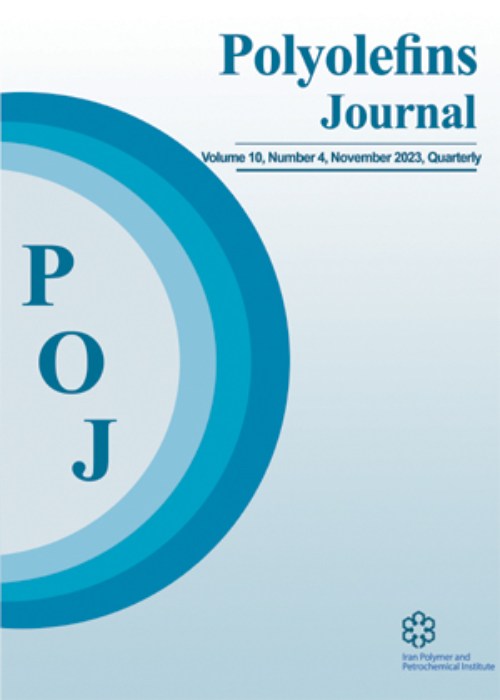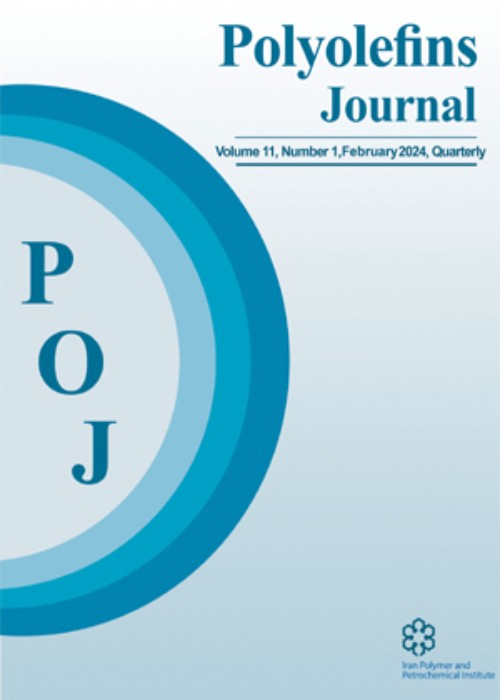فهرست مطالب

Polyolefins Journal
Volume:10 Issue: 4, Autumn 2023
- تاریخ انتشار: 1402/08/10
- تعداد عناوین: 6
-
-
Pages 191-204The time available for proper casting of the polyurethane (PU) system after isocyanate addition (called pot life) affects the macrodiol microstructure. In this research, the effect of molecular weight ( Mn ) of hydroxyl terminated polybutadiene (HTPB) as an important macrodiol on the pot life of polyurethane system was rheologically investigated. The chemorheological behavior of polyurethane systems based on five different HTPBs with Mn ranging from 2810 to 4450 g/mol and two common diisocyantes (TDI and IPDI) were studied in situ. The results showed that by increasing Mn , the rotational viscosity as well as the constant reaction rate of urethane formation increases; whereas the pot life of the polyurethane system decreases. The pseudoplastic behavior of the samples showed the minimum rate constant/longest pot life at a critical molecular weight (Mc) of about 3100 g/mol, which may be due to physical chain entanglements. Rheomechanical spectrometry interestingly depicted that tan δ originated-gel point occurs before the intersection of stored modulus (G') and loss modulus (G") (tgel< tG'=G"). The kinetic model developed by Hsich showed excellent agreement with the cross-linking data of three polyurethane systems.Keywords: HTPB, number-averaged molecular weight, pot life, Gel Time, Dynamic Rheological, polyurethane system
-
Pages 205-210Ethylene-propylene copolymerization reactions were carried out using rac-Et(2-MeInd)2ZrMe2 catalyst and (2,6-tBu2PhO-)AliBu2 as activator under varying reaction conditions. We demonstrate that reaction conditions such as monomer concentration, Al/Zr molar ratio and solvent type (toluene and heptane) all have significant effect on activity of the system and copolymers composition. The decrease in reaction pressure from 11 to 3 atm leads to: a) 1.6-fold increase in specific activity (from 3030 to 4840 kg copolymer/(mol Zr•h•atm)), b) increase of Mn value from 38 to 89 kg/mol, and c) increase of ethylene content in copolymer from 87 to 92 mol %. The increase of ethylene/propylene molar ratio from 0.7 to 2 does not significantly affect activity but leads to the rise in the ethylene content in copolymer from 92 to 97 mol % and, correspondingly, to the increase of copolymer crystallinity from 43 to 48%. As a result, thermal and mechanical properties of the obtained polymers also change, according to the shifts in copolymers composition. The change in Al/Zr molar ratio is confirmed to have great effect on the catalytic activity of our systems. In a row of Al/Zr= 100, 150, 200, 300 mol/mol, the lowest activity of 80 and the highest one of 8550 kg copolymer/(mol Zr•h•atm) are observed at 100 and 150 molar ratios correspondingly. We have also demonstrated the ability of catalytic systems with isobutylaluminum aryloxide activators to operate in aliphatic medium (heptane). On another note, during the reaction quenching, aryloxide activator hydrolyzes the polymer infused with 2,6-di-tert-butylphenol antioxidant. This results in the increased resistance of copolymers to the thermal-oxidative degradation. The presence of 4 wt.% phenol in the copolymer leads to an increase in the 5% mass loss temperature by 67°C. Moreover, increasing the residual phenol content from 2 to 4 wt.% affects the mechanical properties of the copolymers: the elongation-at-break increases from 500 to 600%, and the tensile strength decreases from 10 to 8 MPa.Keywords: metallocene, alkylaluminum aryloxide, ethylene-propylene copolymerization, Properties
-
Pages 211-224Novel EPDM-based polymer foams were prepared using a combination of nanomaterials, namely nano silica, nano clay, and graphene nanoplatelets. In order to achieve optimal acoustic performance, the Taguchi design (TD) technique was applied to reduce the number of experiments and optimize the formulation. By employing an orthogonal array of L9(34), four controlled factors, including content of the three nanomaterials and the blowing agent (Unicell D200A), were chosen. In practice, the acoustic properties of the nine suggested experiments with TD were examined with an impedance tube, and the signal-to-noise ratio analysis revealed two more optimal formulations for foam composites. Further experiments for the last two formulations compared to the nine Taguchi tests, showed an improvement of 13.04 and 19.68%, respectively, for noise reduction coefficient (NRC) and average transmission loss (ATL). It seemed that the idea of using multiple nanomaterials simultaneously is to be an effective way. Besides, the SEM images of nine samples proved that the smaller cell size of the foam were achieved using the higher concentration of nanoparticles. These findings are in accordance with the acoustic results, as the sample with larger cell size and more open cells (C3) showed higher NRC and the sample with larger cell size and closed cells (B2) showed higher ATL values. To complete the study, some blank samples with zero level or only one type of the nanomaterial were also investigated. Interestingly, the obtained results indicated that the formula should contain more than one type of nanoparticle to achieve a better acoustic performance. Comparing the result obtained in this study for EPDM foam with the same EVA foam in our previous work, it can be seen that EPDM showed an increase of 15.56% in NRC and a slight decrease of 2.5% in ATL. This behavior could be due to the difference in their morphology, in which the EPDM has probably more open cells and thinner cell walls.Keywords: EPDM foam, Nanomaterial, Acoustic, Taguchi design, foam morphology
-
Pages 225-233Date palm tree leaf-reinforced polymer composites have important advantages, such as sustainability and low-cost. In the present study, ternary blend composites of polyvinyl chloride (PVC), low-density polyethylene (LDPE), and acrylonitrile butadiene rubber (NBR) copolymer (LDPE/PVC: C0, LDPE/PVC/NBR:C1) as well as reinforced composites with 10, 20, and 30 wt.% of alkali treated date palm fiber (TDPF) (C2, C3 and C4 respectively) were fabricated using a melt blending extrusion process. TDPF and the NBR copolymer were used to improve the interfacial bonding, compatibility, and thermo-mechanical properties of the composite, yielding the highest tensile strength of 32 MPa for the composite containing 10 wt.% TDPF. Moreover, the morphological analysis showed that the incorporation of the NBR copolymer enhanced the compatibility of the blend. Mechanical tests revealed that the hardness of the TDPF/PVC/LDPE/NBR composite increased in the order C2 (450 MPa) < C3 < C4 (540 MPa). In addition, the flexural and tensile moduli of the composite increased with increasing TDPF content, with the highest values (534 and 1585 MPa, respectively) observed for composite C4. Thermal analysis revealed increased Tonset and T10% values, indicating an improved thermal stability of the composite. This study clearly demonstrates that the (DPF/PVC/LDPE/NBR) composites can be used in various high-tech engineering applications, which require excellent properties.Keywords: Polyvinylchloride, low-density polyethylene, acrylonitrile butadiene rubber, alkali treated date palm fiber
-
Pages 235-242The copolymerization of methyl acrylate (MA) and glycidyl methacrylate (GMA) with 1-hexene was carried out using activator regenerator by electron transfer atom transfer radical polymerization (ARGET ATRP) employing Cu(0)/CuBr2 as a catalyst, pentamethyl diethylenetriamine (PMDETA) as a ligand, and ethyl 2-bromoisopropionate (EBriP) as the initiator, all at a reaction temperature of 70°C. This process resulted in the production of viscous and transparent copolymers, namely poly (methyl acrylate-co-1-hexene) or PMH and poly (glycidyl methacrylate-co- 1-hexene) or PGMH. For the MA/1-Hex copolymer, conversion rates ranged from a maximum of 31 wt.% to a minimum of 12 wt.%, while the GMA/1-hexene copolymer exhibited conversion rates ranging from a maximum of 42 wt.% to a minimum of 12 wt.%. It was observed that increasing the amount of 1-hexene during the synthesis led to a higher incorporation of 1-hexene content in both the MA and GMA polymer backbones, with a maximum of 15 wt.% and 18 wt.% of 1-hexene being incorporated into PMH and PGMH, respectively. The incorporation of 1-hexene was confirmed through Nuclear Magnetic Resonance (NMR) studies, including 1H, 13C, and DEPT 135 studies. Additionally, the copolymer PMH and PGMH exhibited monomodal molecular weight distribution curves when evaluated using the size exclusion chromatography (SEC) high-performance liquid chromatography (HPLC) technique, with polydispersity values in the range of 1.19-1.37 and 1.07-1.11, respectively. These findings indicate that the copolymerization process was well-controlled and followed a radical polymerization mechanism.Keywords: ARGET ATRP, methyl acrylate, glycidyl methacrylate, 1-Hexene, Control radical polymerization (CRP)
-
Pages 243-251The concentration of ethylene and 1-butene in n-hexane as polymerization media was calculated at five different pressure levels (4, 6, 8, 10, and 12 bar) and four different 1-butene concentrations (0.13, 0.26, 0.39, and 0.52 mol/L) in n-hexane at T= 80°C using the Peng-Robinson thermodynamic equation of state. Some combinations of conditions were selected to perform the copolymerization reaction in the presence of an industrial TiCl4/MgCl2 Ziegler-Natta catalyst. The forms of the synthesized products were visually and qualitatively classified as either powder or sticky. The percentage of incorporated 1-butene comonomer into the polyethylene chains was analyzed using calibrated FTIR tests. It was shown that for ethylene/1-butene concentration ratios (β) in n-hexane above approximately 1.80, the product forms as a powder. For values below 1.30 threshold, the product was sticky. Thus, this ratio could be used as a criterion for selecting the proper combination of copolymerization pressure and 1-butene concentration when aiming to achieve a powdered form of the product. It was shown that β has a strong correlation with the weight percentage of 1-butene in the final LLDPE polymer. Therefore it can be used as an accurate prediction for wt.% of incorporated 1-butene into the LLDPE chain within the studied concentration ranges with the specific catalyst system utilized.Keywords: Zeigler-Natta catalyst, LLDPE, ethylene-1-butene copolymerization, 1-butene incorporation, Peng-Robinson Equation of State


